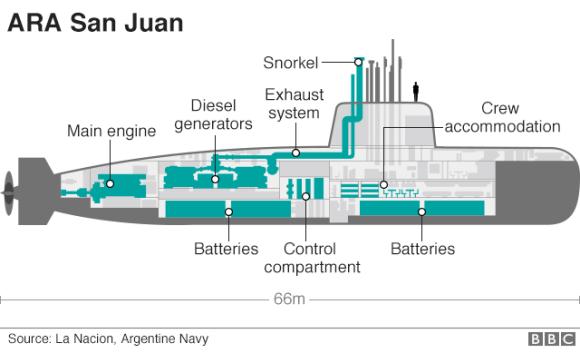 The news of the Argentine submarine ARA San Juan, missing since a week ago last Wednesday, has been uniformly grim. A report on Tuesday of a “heat stain” picked up by a US search place has come to naught.
The news of the Argentine submarine ARA San Juan, missing since a week ago last Wednesday, has been uniformly grim. A report on Tuesday of a “heat stain” picked up by a US search place has come to naught.
More disturbing is a report by the Vienna-based Comprehensive Nuclear-Test-Ban Treaty Organization (CNTBTO) which said that data recorded by its hydro-acoustic stations detected an “underwater impulsive event” shortly after the submarine disappeared in an area close to the the vessel’s last reported position. CNTBTO monitors compliance with the proposed nuclear test ban treaty and has 11 hydro-acoustic stations positioned around the world listening for signs of nuclear explosions.
Argentine Navy spokesman, Enrique Balbi, described the event as “an anomalous, singular, short, violent and non-nuclear event, consistent with an explosion…”
ARA San Juan had reported a “short circuit” in the vessel’s batteries. It disappeared with a crew of 44. The submarine was under the command of Pedro Martín Fernández, when she disappeared. One of the officers is Eliana María Krawczyk, the first female officer in Argentina to serve on a submarine.

The “Main Engine” , for clarity, is the “propulsion motor” and is a large electric motor capable of working off the batteries or the generators.
A nice, simple diagram.
consistent with an explosion…”
Shouldnt that read “implosion”?
The water in that area is not deep enough to implode a sub, and the acoustic signature for an implosion is distinctly different from an explosion.
On a sub that small it would not take much of an explosion from any source to potentially disable/sink the vessel. Hydrogen gas from a battery malfunction might do it, as would a weapons malfunction ala the Kursk.
If they can locate the wreck, there is a good chance of finding a definitive cause. Till then, its all speculation.
Thankyou for the clarification
There’s an unusually high-quality backgrounder on this at CNN:
http://www.cnn.com/2017/11/20/americas/argentina-submarine-what-we-know/index.html
“The submarine was heading from a base in southern Argentina’s Tierra del Fuego archipelago to its home port in Mar del Plata, about 260 miles south of Buenos Aires. It was scheduled to arrive there Sunday.
The San Juan was last spotted in the San Jorge Gulf, a few hundred kilometers off the coast of southern Argentina’s Patagonia region and nearly midway between the bases. The submarine has a crew of 44.”
That indeed would put it at substantially less than its crush depth as the gulf apparently is not more than 300′ deep (and with a soft bottom).
That also makes me wonder if the CNTBTO report really attaches to the sub; if my understanding is correct long distance propagation and transmission of sound originating in such a relatively shallow bay would not be very good.
Implosion at 6+ miles down.
Argentina’s San Juan submarine may have imploded after sinking to …
http://www.abc.net.au/news/2017-11-24/argentinas-san…submarine…imploded/9188220
2 days ago – An explosion recorded just hours after an Argentinian submarine went missing makes it look unlikely any of the 44 men and women on board
http://www.abc.net.au/news/2017-11-24/argentinas-san-juan-submarine-may-have-imploded/9188220
Submarines have suffered from internal explosion from very early on, on 8th June 1905 submarine boat A8 the first class of British submarine which was a modified Holland was seen to dive unexpectedly when 400 yards off Plymouth breakwater, these early submarines had batteries, petrol engines and electric motors a lethal combination, it is suspected a spark ignited petrol fumes causing that explosion, it was not until A13 that British submarines were fitted with diesel engines, Chlorine gas leakage from batteries in submarine environments have always been a problem it only takes a single spark, My great uncle Stephen Aaron Birch was one of the 15 who died in that explosion in 1905 when such boats were still experimental. I wonder what my friend Tom Lewis might have to say. For 24 years he was a diesel PO in RN submarine boats.
Chris, Not Chlorine gas!
Besides, it there is no power to run anything, what is charging the batteries?
The charging of lead-acid batteries can be hazardous. However, many workers may not see it that way since it is such a common activity in many workplaces. The two primary risks are from “hydrogen gas” formed when the battery is being charged and the sulfuric acid in the battery fluid.
I stand corrected on chlorine gas